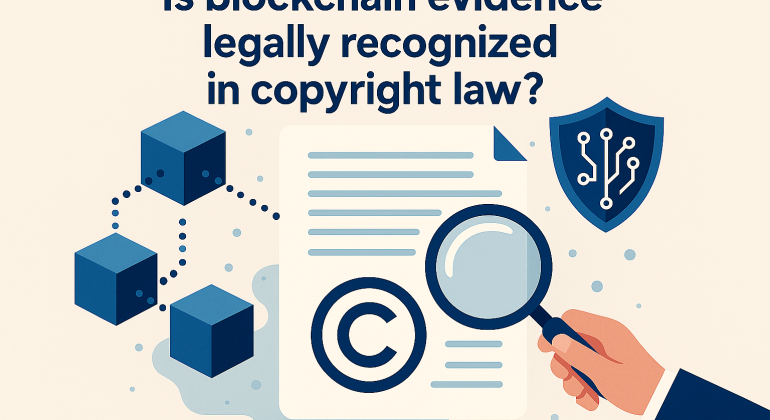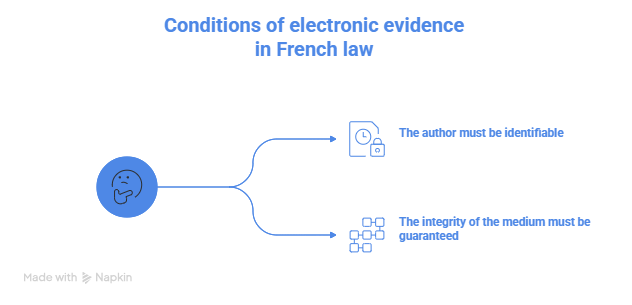Sommaire
Introduction
Blockchain evidence is currently attracting growing interest, particularly in copyright law, where questions of prior art and ownership is often crucial. But is blockchain really recognized as a valid form of evidence before French courts? In a decision handed down by the Marseille Judicial Court on March 20, 2025, blockchain timestamping was accepted and legally recognized as legitimate evidence of copyright ownership.
Legal basis for evidence
Under French law, the principle of freedom of evidence prevails. However, in matters where literal evidence is possible (including copyright), a minimum level of formality is required. Article 1358 of the French Civil Code provides that electronic documents are admissible as evidence in the same way as paper documents, provided that the author is identifiable and the integrity of the medium used is guaranteed.
Nevertheless, no French text yet expressly recognises blockchain as evidence. The legal framework surrounding blockchain evidence is therefore being shaped through the articulation between freedom of evidence, adaptation of evidentiary rules to technological developments, and emerging case law.
Blockchain as evidence in copyright litigation
Blockchain is a technology for storing and transmitting information, characterised by its decentralisation, transparency and security. Unlike centralised systems, it operates without a single controlling authority. Each transaction is recorded in a shared ledger, forming a chain of tamper-proof information.
Blockchain evidence works like a large, accessible and secure register, where each transaction is recorded in the form of “blocks” linked to each other. Each new block contains a unique cryptographic fingerprint (hash) of the previous block, forming a chain that is virtually immutable. The blockchain is replicated across thousands of nodes worldwide, making any unauthorized alteration practically impossible.
To learn more about how blockchain evidence works, please see our previously published article on the subject.
The Marseille Court decision of March 20, 2025: a turning point
In this case, AZ FACTORY accused Valeria Moda of marketing clothing featuring the designs of its “Hearts from Alber” and “Love from Alber” creations. These creations were highly evocative sketches created by Alber Ebaz, a renowned fashion designer.
AZ Factory had previously registered the sketches of these designs on the blockchain, fact later verified through a bailiff’s report produced during the proceedings.
In its decision of March 20, 2025, the Court recognised that blockchain timestamps could establish ownership of copyright. It held that registration on the blockchain, together with the corresponding record, was sufficiently reliable to demonstrate authorship and ownership, particularly when corroborated by other elements such as publication on social networks or trademarks appearing on the garments.
However, the Court specified that blockchain evidence was not considered in isolation: it was one element amongst a “block of evidence”. According to this decision, it is therefore not possible to consider blockchain registration as “pure” and independent evidence in itself, with significant legal force.
This decision can be described as “blockchain-friendly”: it opens the door to the use of this technology in intellectual property matters, while preserving the judge’s discretion in assessing evidentiary value.
Doctrinal perspectives and expected legislative developments
Activist scholars and practitioners advocate for legislative regulation to confer evidentiary value on certain reliable blockchain records. However, the challenge lies in defining the necessary technical conditions, such as the type of blockchain, audit mechanisms, and certification bodies, without unduly constraining the technology.
Conclusion
Blockchain-based evidence is now deemed admissible before French courts to establish the prior existence and ownership of a protected work, provided that the underlying technical system is reliable and the judge is convinced of its integrity. However, this type of evidence does not replace other elements of the “block of evidence”: its effectiveness depends on the quality of its implementation, the complementarity of the supporting evidence and the strength of the legal reasoning.
Key takeaway: blockchain registration is a valuable evidentiary, but not an absolute guarantee.
Dreyfus & Associés assists its clients in managing complex intellectual property cases, offering personalized advice and comprehensive operational support for the complete protection of intellectual property.
Nathalie Dreyfus with the support of the entire Dreyfus team
FAQ
1. Is it necessary to involve a bailiff when using blockchain as evidence?
It is highly recommended. A bailiff can certify that the file registered on the blockchain corresponds to the work in question and guarantee the integrity of the procedure.
2. What are the main advantages of blockchain-based evidence?
- Certain and tamper-proof dating of the work
- Immutability of the record
- International traceability without dependence on a national registry
3. What are the risks or limitations of using blockchain as evidence?
- Anonymity or pseudonymity of users, making it difficult to identify the author
- Lack of technical audit of the protocol
- Insufficient probative value if used in isolation without supporting evidenceTechnical complexity for jurisdictions unfamiliar with the technology
4. Is blockchain recognised as evidence in other countries?
Yes. China, Italy and the United States have already recognised the probative value of blockchain records, particularly for proof of prior art or ownership in copyright and patent matters. France is gradually aligning itself with this trend.
5. Can blockchain be used for all types of works (design, software, music)?
In theory, yes, provided that the use of blockchain is technically suitable and appropriately tailored to record and verify the specific type of work concerned.


